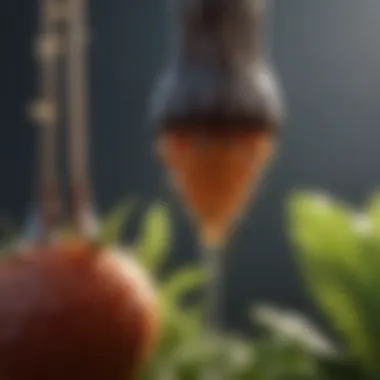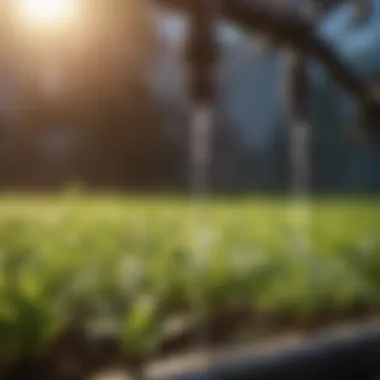Understanding Micro Drippers: A Comprehensive Guide


Intro
Micro drippers have become a key element in modern irrigation methods, particularly as the demand for efficient water use in agriculture grows. These devices ensure that plants receive adequate water directly to their roots while minimizing waste. Understanding how micro drippers function and their advantages is essential for those involved in agricultural practices.
Overview of the Topic
Definition and Importance
Micro drippers, sometimes referred to as drip emitters, are devices that release water slowly and precisely at the base of plants. This method of irrigation provides numerous benefits including,
- Water efficiency: Reduces evaporation and runoff.
- Targeted delivery: Ensures that roots receive water directly, promoting healthier plant growth.
- Reduction in disease: Limiting moisture on plant leaves can help prevent fungal diseases.
Overall, micro drippers play a vital role in sustainable water management in agriculture.
Current Trends
The agricultural industry is evolving rapidly, and so is the technology surrounding micro irrigation systems. Current trends include the adoption of smart irrigation technologies that allow for remote monitoring and control, helping farmers to optimize their water usage based on real-time data. Furthermore, eco-friendly materials for micro drippers are increasingly being developed to enhance sustainability.
Key Techniques and Practices
Step-by-Step Guide
- Planning the System: Evaluate crop needs and topography.
- Choosing Micro Drippers: Select the appropriate type based on water flow rate and spacing.
- Installation of Tubing: Lay main and lateral tubing according to planned layout.
- Placement of Drippers: Position drippers close to selected plants.
- Pressure Testing: Ensure that water reaches all drippers effectively.
Tools and Equipment Needed
- Micro tube connectors: Essential for assembling the dripper system.
- Pressure regulator: Maintains optimal pressure for effective water distribution.
- Filters: Removes particulate matter to prevent clogging.
- Flow meters: Helps monitor water usage and flow rates.
Challenges and Solutions
Common Obstacles
While micro drippers can optimize irrigation, they are not without challenges. Common issues include:
- Clogging: Biological growth or sediment can obstruct flow.
- Uneven Water Distribution: Results from pressure fluctuations or incorrect placement.
Innovative Solutions
Addressing these challenges requires proactive strategies, such as:
- Regular maintenance: Schedule routine checks to clean filters and drippers.
- Use of anti-drip technology: This can prevent water from dripping when the system is off, reducing waste.
"Effective management of micro drippers can significantly enhance crop yields and sustainability, ultimately benefiting both farmers and the environment."
Preface to Micro Drippers
Micro drippers have become a crucial aspect of modern irrigation strategies. This technique allows for efficient water delivery directly to the root zone of plants. The rise of precision agriculture emphasizes the importance of conserving water and enhancing crop yield. As traditional irrigation methods consume large amounts of water and often lead to runoff or evaporation, micro drippers provide a more effective alternative. They minimize wastage and ensure that crops receive the right amount of moisture, which is vital for sustainable farming.
Definition and Functionality of Micro Drippers
Micro drippers, often referred to as drip emitters, are small devices attached to irrigation tubes. Their primary function is to release water at a controlled rate directly into the soil around plant roots. This method reduces evaporation and run-off, making it ideal for drier climates. Typically, they operate under low pressure and are designed to provide a steady flow of water over extended periods.
Micro drippers can vary in design and output rate, but generally, they can release anywhere from 0.5 to several liters per hour, which can be adjusted depending on crop needs. The specific type of micro dripper chosen can significantly impact the overall efficiency of an irrigation system, influencing both water savings and plant health.
Historical Development in Irrigation Technology
The evolution of irrigation technology has seen significant changes over the centuries. In ancient times, farmers relied on simple methods like flooding. With increasing awareness of soil conservation, the need for more efficient systems became apparent. The modern concept of micro irrigation began to take shape in the 1960s, driven by advancements in plastic manufacturing.


Israel played a pivotal role in the development of micro drippers. The harsh climatic conditions prompted researchers to innovate new irrigation techniques. This led to the creation of drip irrigation systems that would transform agricultural practices worldwide. The introduction of micro drippers supported not just crop production but also the ability to grow crops in previously inhospitable areas. Over time, this technology has been refined and adapted, leading to more efficient designs and smarter applications.
Advancements in materials and technology continue to enhance the functionality and durability of micro drippers. The integration of sensors and smart technology is the next phase in this evolution, promising even greater efficiencies and precision in water usage.
The shift towards micro irrigation represents a significant advancement in agricultural technology, enabling farmers to produce more with less water in an era of growing concern over resource scarcity.
Mechanics of Micro Drippers
The mechanics of micro drippers are vital to understanding how they function and why they are favored in precision irrigation systems. This section outlines how micro drippers work, their various types, and the specific features that distinguish these irrigation tools from traditional methods. The emphasis here is not merely on their operational aspect, but also on how their design and functionality contribute to improved water efficiency in agriculture.
How Micro Drippers Operate
Micro drippers function by delivering exact amounts of water directly to the root zone of plants. This method reduces waste by minimizing evaporation and runoff. Each micro dripper releases water at a slow, controlled rate. The operation begins when water flows from a pressurized source through pipes leading to the drippers. A series of small emitters regulate the flow rate. By adjusting these emitters, farmers can customize water distribution based on the needs of different crops. This targeted approach ensures that plants receive adequate moisture without over-saturation, which could cause root rot or fungal disease.
Understanding how micro drippers operate can significantly influence farmers in resource management. With climate change intensifying drought conditions, efficient water use has become critical. Many agricultural stakeholders have recognized this technology's role in securing crop health even in arid environments.
Types of Micro Drippers
Micro drippers can be categorized primarily into two types: pressure compensating micro drippers and non-pressure compensating micro drippers. Each type has unique mechanisms and benefits that suit specific planting and irrigation needs.
Pressure Compensating Micro Drippers
Pressure compensating micro drippers maintain a constant flow rate regardless of the water pressure in the system. This characteristic is particularly advantageous in uneven terrain, where water pressure can vary significantly. The mechanism usually incorporates a diaphragm that adjusts to changes in pressure. The benefit of this feature is that it guarantees uniform water distribution across all plants, regardless of their position in the irrigation layout.
Farmers often prefer pressure compensating drippers because they help in optimizing water efficiency. The consistent flow leads to healthier plants and potentially higher crop yields. However, this type can be slightly more expensive than others and may require more maintenance due to its complex design.
Non-Pressure Compensating Micro Drippers
Non-pressure compensating micro drippers, as the name suggests, do not adapt to pressure changes. They operate effectively in situations where water pressure is stable and uniform. These drippers generally have simpler designs, making them easier to install and maintain. The main advantage of this type is its lower cost and availability, making them an appealing choice for many small-scale farmers.
While these drippers can be efficient under optimal conditions, they do have limitations in varied pressure settings. In sloped fields, lower areas may receive more water than higher areas, which could lead to uneven moisture levels. This unevenness can impact plant health and yield, therefore requiring careful consideration of the field’s layout before installation.
Benefits of Using Micro Drippers
Micro drippers are pivotal in modern agricultural practices, particularly in the realm of precision irrigation. Their benefits extend beyond mere water delivery; they encompass environmental sustainability, economic considerations, and improved agricultural outcomes. Understanding these benefits is crucial for farmers and enthusiasts committed to maximizing resource efficiency.
Water Conservation and Efficiency
Micro drippers excel in water conservation. Traditional irrigation methods often lead to significant water loss due to evaporation or runoff. In contrast, micro drippers deliver water directly to the soil near plant roots, minimizing waste and maximizing absorption. This targeted approach reduces moisture loss and ensures that crops receive the optimal amount of water.
- Reduced Water Usage: Farmers can achieve the same crop yields while using 30-50% less water compared to conventional methods.
- This reduction is crucial in regions facing water scarcity, allowing for sustainable agricultural practices.
- Localized Irrigation: By focusing water application on specific areas, micro drippers help establish healthier root systems and stronger plants.
Implementing micro drippers not only conserves water but also enhances operational efficiency. Groundwater levels are better maintained, positively influencing local ecosystems.
Enhanced Crop Yield and Quality
One of the most compelling reasons to adopt micro drippers is their impact on crop yield and quality. When plants receive a consistent and adequate supply of water, they tend to thrive more effectively. This leads to
- Higher Yields: Micro drippers enable better control over the amount and timing of water delivery, resulting in a more favorable environment for growth.
- Quality of Produce: Consistent moisture levels contribute to uniform crop development. This leads to fruits and vegetables that are not only larger but also more flavorful.
- Disease Reduction: Optimal watering conditions can also decrease the incidence of root diseases, allowing farmers to minimize pesticide usage.
Farmers report that with micro drippers, their harvests are more abundant and of superior quality. This translates into higher market prices and better profitability.
Soil Health Benefits
Soil plays a crucial role in agriculture, and micro drippers contribute positively to soil health. The efficient water delivery minimizes soil erosion and nutrient leaching, two common issues in traditional irrigation. Moreover,
- Aeration: By avoiding oversaturation, micro drippers promote better aeration and root respiration.
- Nutrient Retention: Techniques such as fertigation, where fertilizers are applied through the irrigation system, can be easily integrated with micro drippers. This can lead to improved nutrient uptake by crops.
- Soil Structure: Regular and controlled watering helps maintain soil structure, avoiding compaction that can negatively affect plant growth.


Design Considerations for Micro Drippers
Designing an irrigation system involving micro drippers is a crucial aspect of successfully maximizing both water efficiency and crop yield. The right choice of components and installation methods can have long-lasting effects on the system’s performance. Factors like soil type, crop requirements, and environmental conditions must be taken into account. By paying attention to these details, growers can ensure optimal water delivery and sustainability.
Selecting the Right Micro Dripper
Choosing the appropriate micro dripper is essential for achieving desired irrigation goals. There are various types available, each having distinct features that cater to different applications. Here are key factors to consider:
- Flow Rate: Knowing the flow rate is vital. Drippers with different flow rates deliver water at different speeds. One must select based on crop requirements. For instance, a crop needing high moisture will benefit from drippers with higher flow rates.
- Pressure Compensation: Pressure-compensating drippers maintain consistent flow rates regardless of the pressure in the system. This is especially useful on uneven terrain, where variations in pressure can cause inconsistent watering.
- Emitter Design: There are several emitter designs, including integrated and inline systems. Each has its unique benefits, such as ease of maintenance or adaptability to existing infrastructure. Evaluate these based on the irrigation setup.
- Durability: The materials used in the drippers determine how long they will last. With harsher environments, like high salt concentrations or extreme temperatures, the right material choice is necessary to avoid frequent replacements.
After careful consideration of these factors, selecting the correct micro dripper for the intended application will contribute significantly to irrigation performance and overall crop yield.
Installation Best Practices
The installation of micro drippers directly impacts their effectiveness and longevity. Adhering to proper installation guidelines can minimize future issues and enhance operational efficiency. The following best practices should be observed:
- Plan Layout: Before installation, develop an organized layout. This involves mapping out plant spacing and the expected water delivery. Adequate spacing between drippers ensures even water distribution and prevents over-saturation in certain areas.
- Check Compatibility: Ensure that all components of the irrigation system are compatible. Mixing different types of drippers or materials can lead to inefficiencies and potential failures in the system.
- Testing Pressure Levels: It is critical to test the system’s water pressure. This will help identify any irregularities that may affect performance. Adjusting the system to maintain optimal pressure levels will enhance efficiency.
- Consider Maintenance Access: Easy access to the micro drippers is essential for maintenance. Position them in a way that ensures accessibility without disturbing the crops.
- Regular Monitoring: After installation, monitor the system’s performance regularly. Look for any signs of clogs or dripping inefficiencies. Addressing these promptly can save time and resources over the long term.
Implementing these installation best practices will help in achieving a sustainable and effective irrigation system with micro drippers, ultimately leading to improved agricultural productivity.
Maintenance of Micro Drippers
Maintaining micro drippers is essential for ensuring optimal performance in irrigation systems. Proper maintenance can significantly extend the lifespan of equipment while preventing costly failures. Regular attention to this aspect plays a critical role in achieving effective water management in agricultural practices.
Regular Cleaning and Inspection
Regular cleaning of micro drippers is necessary to prevent blockages caused by soil particles, algae, and mineral deposits. These contaminants can lead to uneven water distribution, which affects plant health and growth. The maintenance routine should include:
- Visual Inspection: Inspect for visible damage or leaks on the drip lines.
- Flushing System: Periodically flush the entire irrigation system to remove build-up.
- Cleaning Filters: Remove and clean filters that separate debris from the water supply.
In addition, it’s important to schedule inspections at the beginning and end of the growing season. This prepares the system for optimal performance, especially before high-demand periods.
Identifying and Troubleshooting Issues
Identifying issues early helps in maintaining the functionality of micro drippers. Ignoring early signs can result in larger problems down the line involving crop yield and quality. Typical issues that may arise include:
- Uneven Water Distribution: This may be observed through changes in plant condition across the garden. To troubleshoot, check for blockages in lines and replace any damaged drippers.
- Low Pressure: Insufficient water pressure can affect distribution. Investigate pressure gauges and ensure that pumps are functioning properly.
- Persistent Clogging: If clogging recurs, consider the water quality. High mineral content may necessitate the use of filtration systems.
By regularly inspecting and addressing these issues, farmers can minimize downtime and ensure that the irrigation system operates efficiently.
"The maintenance of micro drippers not only saves water but also enhances crop productivity through consistent and precise irrigation techniques."
Through proper cleaning, inspections, and troubleshooting, farmers can maintain efficient irrigation systems that help optimize water usage and improve crop yields.
Environmental and Economic Impact of Micro Drippers
The environmental and economic implications of micro drippers are significant, particularly in the landscape of modern agriculture. As we grapple with changing climate patterns and increasing water scarcity, efficient irrigation systems such as micro drippers have emerged as essential tools for sustainable farming. This section elucidates the relevance of these systems in conserving water and optimizing costs, ultimately enhancing agricultural outputs.
Sustainability and Water Resource Management
Micro drippers play a crucial role in sustainable agricultural practices. They deliver water directly to the root zone of plants, reducing evaporation and runoff, which are pervasive issues in traditional irrigation methods. Water efficiency is of utmost importance for farmers, especially in arid regions where every drop counts.
- Reduction in Water Usage: Studies show that micro drippers can decrease overall water usage by up to 50% compared to conventional methods. This reduction not only conserves a vital resource but also minimizes the energy needed for water transport.
- Maintaining Soil Moisture: By delivering water in a controlled manner, micro drippers help maintain consistent soil moisture levels. This promotes healthier crop growth and yields while minimizing the risk of disease associated with overwatering.
- Environmental Preservation: Efficient water management subsequently contributes to environmental preservation. Reduced water extraction from local sources helps maintain ecosystem balance, ensuring that other flora and fauna remain supported.
"Sustainable practices in agriculture are not just a choice; they are a necessity for future generations."
Cost-Benefit Analysis for Farmers


Understanding the economic benefits that micro drippers bring to the table is key for farmers considering this technology. The initial investment may seem substantial, yet the long-term savings and benefits are remarkable.
- Initial Investment vs. Long-Term Savings: While the upfront cost of micro drippers might be higher than traditional systems, the durability and efficiency often translate into long-term savings, both in water bills and labor costs.
- Increased Crop Yields: The precise watering provided by micro drippers can lead to enhanced crop yields. Healthier, well-watered plants typically produce higher quality crops, directly impacting farmer income.
- Reduction in Labor Costs: A properly installed micro irrigation system requires less monitoring and manual effort compared to traditional irrigation. This efficiency allows farmers to allocate resources to other essential areas of their operations.
Case Studies on Micro Drippers
Case studies on micro drippers play a vital role in understanding their practical application in agriculture. They provide real-life insights into how micro drippers perform across different types of crops and environmental conditions. By analyzing successful implementations alongside lessons from failures, farmers and agronomists can draw valuable conclusions that may enhance their irrigation practices. These case studies are crucial because they illustrate not only the benefits but also the potential pitfalls to avoid in micro irrigation implementation.
Successful Implementation in Various Crops
The success of micro drippers in various crops highlights their versatility and effectiveness in ensuring optimal water distribution. For instance, in regions where water scarcity is a pressing issue, such as in parts of California or Australia, farmers have employed micro drippers to maximize their water use efficiency.
In tomato cultivation, farmers reported that micro drippers lead to reduced water usage by up to 60% while improving yield quality. Precise water application helps maintain moisture at root levels, promoting healthier plants.
Similarly, in vineyards, the use of pressure compensating micro drippers allowed for uniform water delivery across the sloped terrain. This particular case study emphasized that fruit quality improved alongside lower water consumption. The drip system facilitated not just water conservation but also enhanced fruit sugar concentration due to controlled irrigation.
Other examples show positive results in vegetable farming, especially leafy greens, where rapid growth is essential. Farmers found that adjusting drip rates based on the plant's growth stage optimized resource usage and minimized water stress. These case studies underscore the importance of tailoring micro dripper systems to the needs of specific crops, leading to both environmental and economic benefits.
Lessons Learned from Failed Installations
While successful implementations provide optimism, learning from failures is just as important. Several case studies document instances where micro drippers did not yield the expected results, typically due to improper installation or lack of maintenance.
One common mistake involved incorrect emitter sizing. Farmers either underestimated or overestimated the flow rate needed for their crops. As a result, some crops received too little water, while others suffered from root decay due to overwatering. For example, in a corn crop installation, the mismatch in emitter sizes led to uneven growth patterns and substantial yield loss.
Moreover, failures also highlighted the significance of regular maintenance. In a few cases, clogs in the drip lines went unaddressed, causing plants to suffer from drought stress. An incident in a strawberry farm revealed that neglecting straining filters led to emitter blockages, wasting both water and resources.
These lessons illustrate the need for detailed planning and diligent monitoring of micro dripper systems. Ensuring that the right product is chosen, correctly installed, and regularly maintained can be the difference between an efficient irrigation system and one that fails to deliver.
"Investing time in understanding case studies can guide farmers in making informed decisions, optimizing both yield and resource management."
Future Trends in Micro Dripper Technology
The evolution of micro drippers is pivotal in the context of modern agriculture. Their role is not only to enhance irrigation efficiency, but also to contribute to sustainable farming practices that can meet the increasing global food demand. Keeping up with future trends in micro dripper technology is essential for farmers and stakeholders in the agricultural sector. The need for innovations aimed at resource conservation and productivity is becoming more crucial.
Innovations and Advancements
Recent innovations in micro drippers focus on improving efficiency and adaptability. One of the most significant advancements is the development of self-cleaning micro drippers. These drippers are designed with features that prevent clogging, thus reducing maintenance efforts. Additionally, advancements in materials used in their construction have led to products that are more durable, weather-resistant, and capable of withstanding various environmental conditions.
Another realm of innovation involves automated systems that adjust water delivery based on real-time soil moisture data. These systems ensure that crops receive just the right amount of water, thus optimizing usage. The integration of chemicals and fertilizers through micro drippers is also becoming more common, allowing farmers to apply nutrients more effectively and evenly across the field.
Integration with Smart Farming Solutions
The integration of micro dripper systems with smart farming technologies marks a significant trend in agriculture. Technologies like Internet of Things (IoT) sensors are increasingly being used to monitor soil conditions and crop needs. This data-driven approach allows for better decision-making concerning irrigation practices. Utilizing cloud-based platforms, farmers can manage multiple dripper systems remotely, adjusting water flow based on real-time feedback.
The use of drones is another innovative aspect that enhances the precision of micro dripper installations. Drones can survey and assess crop health, helping to identify areas that may require different irrigation strategies. Moreover, machine learning algorithms can predict future water requirements based on environmental factors, ensuring that micro drippers work in conjunction with overall farm management strategies.
"The future of agriculture lies in the seamless integration of technology and traditional practices to achieve sustainable farming goals."
In summary, trends in micro dripper technology are promising. They not only offer solutions to the challenges of water scarcity and crop management, but also align with broader efforts to promote sustainability in agriculture. As these technologies continue to develop, farmers will benefit from efficient irrigation methods that enhance productivity without compromising environmental integrity.
End
In the realm of modern agriculture, the use of micro drippers is paramount for enhancing irrigation practices. This article has explored the significant elements that underscore their importance. Micro drippers not only promote water efficiency but also enhance crop performance while ensuring sustainable farming. Their reliability and simplicity provide substantial advantages to farmers and horticulturalists alike.
The benefits of micro drippers extend beyond mere water management. They contribute to soil health by preventing water stagnation and encouraging deeper root growth. Additionally, they can lead to notable increases in crop yield and quality, which is vital in today's competitive agricultural landscape.
Final Thoughts on Micro Drippers in Agriculture
Implementing micro drippers represents a progressive step toward sustainable farming. Farmers who recognize the value of precision irrigation can optimize their resource usage, resulting in both economic and environmental dividends.
- Efficient water use reduces costs related to water acquisition.
- Improved crop yield leads to higher revenues.
- Enhanced soil conditions foster sustainable agricultural practices.
"Micro drippers offer a highly efficient irrigation solution that aligns with the goals of modern agriculture, marrying sustainability with productivity."



